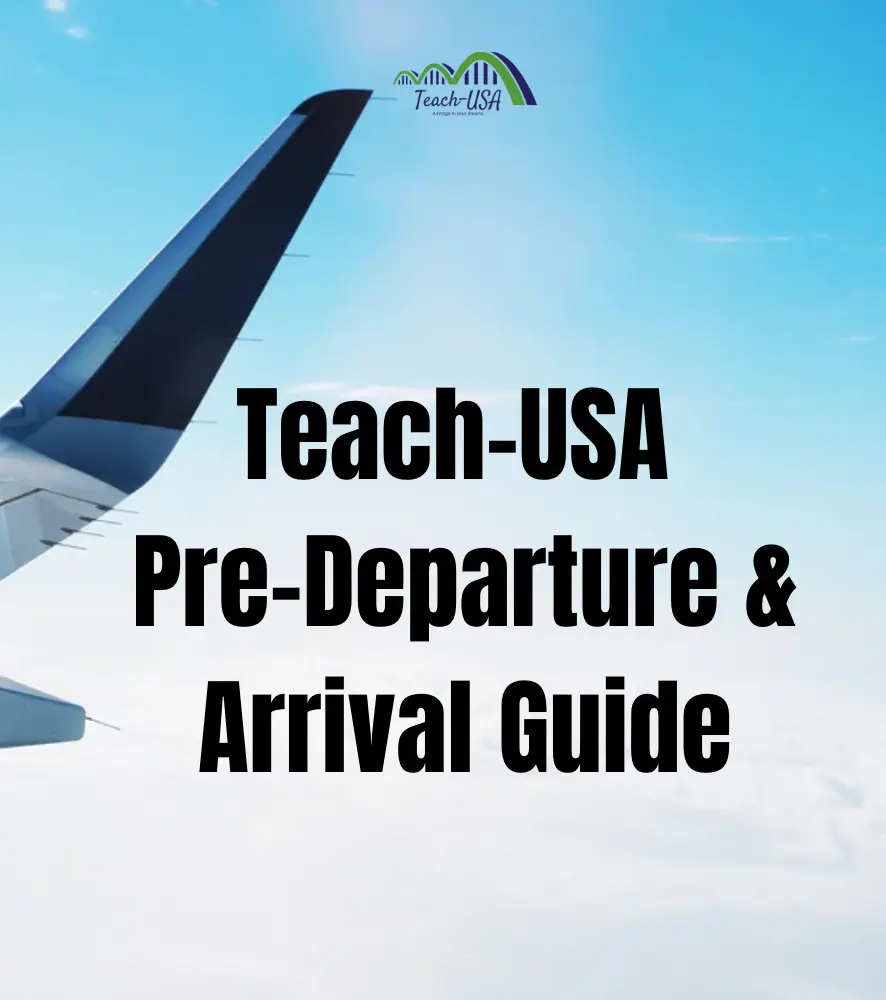Congratulations on reaching this exciting point in your Teach-USA journey! You’re now just days away from starting your new life as an educator in the United States.
This guide outlines what to do before your flight, what to expect upon arrival, and how to transition smoothly during your first weeks. Please read it thoroughly and save a copy for your reference.
PRE-DEPARTURE GUIDE
1. Final Checklist Before Your Flight
- Check the completeness of your documents and bags
- Review airport and airline protocols
- Check the weather forecast in your destination city
- Arrive at the airport 4 hours before your scheduled flight
- Print multiple copies of your important documents
2. What to Bring
HAND CARRY:
- Passport with valid visa
- Signed DS-2019
- Job offer letter
- Sealed TOR and PRC license/ID
- NBI clearance (if available)
- Proof of travel insurance
- Wallet (USD cash, valid ID, debit/credit cards)
- Mobile phone and charger
- Pen and small notebook
- One change of clothes (in case baggage is delayed)
- Personal medications with prescriptions
- TSA-approved toiletries
- Optional: Travel SIM card
CHECKED BAGGAGE:
- Lightweight and warm-weather clothing
- Sweater or jacket
- Pajamas and undergarments
- Shoes and slippers
- Raincoat or umbrella
- Cultural attire (e.g., Barong, Maria Clara)
- Canned goods or snacks (optional, check airline guidelines)
- Pasalubong to your Principal/HR (optional)
- Teaching materials (optional)
3. Be Prepared Mentally
This journey may stretch you. Expect challenges, discomforts, and delays—but also incredible growth. Be resourceful. Be kind. Be focused.
ABOUT TEACH-USA RELOCATION GUIDANCE & FACILITATION
Teach-USA’s airport pickup, apartment search, and car assistance are optional services.
These services were included before, but now that we’ve reduced our facilitation fees, they’re optional to give teachers more flexibility and help cut down on costs.
If Teach-USA didn’t pick you up from the airport or accompany you to your apartment, the reason is simple: you chose to do it independently—and that’s perfectly okay. Many teachers take this route successfully.
Here’s how you can do it easily:
- Ask relatives or friends in the U.S. if they know someone in your assigned city/state.
- Tap into FB group pages for your school district or Filipino teachers.
- Network with friends of friends.
- Contact your principal to learn about other Filipino teachers.
- Ask us—if we know anyone in your area, we’ll gladly refer you to them (free of charge)
If you later decide you need assistance, you may request a quote for Teach-USA’s optional services. Fees may vary depending on proximity to our bases in New Mexico or Nevada and how long support is needed. You may pay after US arrival.
UPON ARRIVAL IN THE U.S.
- Confirm Arrival with Your Sponsor. As soon as you arrive on U.S. soil, your first step should be to call or email your sponsor to confirm your arrival and next steps. Let them know you are safe and ready to begin your onboarding steps. Some sponsors may require confirmation for visa compliance, so don’t delay.
- Apply for I-94 Record. Go to: https://i94.cbp.dhs.gov/I94/#/home Click on “Apply for New I-94” and download a copy. (We’ll send all sample documents via email.) You’ll need this for:
- SSN application
- School HR onboarding
- Bank account setup
- Secure Immediate Needs
- Check in at your hotel or apartment and ensure you have internet access.
- Buy essential items: toiletries, food, temporary bedding, utensils.
- Visit nearby stores (e.g., Walmart, Target, Dollar Tree) or ask fellow teachers for help.
- Start Setting Up Your Life
- Apply for your Social Security Number (after 3-5 business days of arrival).
- Open a bank account (Wells Fargo allows accounts even without SSN).
- Download transportation apps like Uber, Lyft, or local bus/train apps.
- Buy a U.S. SIM card or phone with data (Walmart, Target, Best Buy have budget options).
PROFESSIONAL COURTESY & CONFIDENTIALITY
Once you arrive, it’s common for others to ask about your journey—how much you paid, who helped you, and what the process was like.
We kindly ask that you honor the integrity of the Teach-USA process.
If someone is interested in learning more, the best way to help is to say:
“Please email apply@teach-usa.net for accurate guidance.”
PAYMENT REMINDER
If you still have an outstanding balance for Teach-USA services:
- A QuickBooks invoice will be sent for debit/credit card payments
- You may also send payment via Zelle to: gemma@teach-usa.net
Please avoid comparing fees or payments with others. Everyone’s agreement is different.
TRANSPORTATION OPTIONS
Secure your U.S. driver’s license by checking your state’s Motor Vehicle Department (search for the government site, not private companies).
- Walking – If safe and convenient, walking is the healthiest and most affordable option. Many teachers walk to nearby stores, parks, or even schools.
- Public Transport – Buses and trains are often available in urban areas. Google Maps can help you plan your route.
- Rideshare Apps – Download Uber or Lyft. You’ll need a debit card from a U.S. checking account. Wells Fargo allows account opening even without SSN, but you can only create online access once your SSN arrives.
- Carpooling – Share rides with fellow teachers. It saves money and builds community.
- Rental Cars – You may rent daily, weekly, or monthly (a U.S. license and insurance are typically required).
- Buy a Secondhand Car – If you already hold a Philippine driver’s license, you may have an easier path to securing a U.S. license. Secondhand cars in good condition may cost between $3,000–$8,000. This is often more affordable than new cars and helps you save over time.
CREDIT CARD GUIDANCE
Do not apply for a credit card immediately.
Wait until you:
- Receive your first paycheck
- Have an active U.S. bank account
Why wait?
- You’ll need income proof
- Early denial may affect your credit score
- Better cards are available once you’re financially established
Once you’re ready, we’ll send you a list of beginner-friendly cards with no annual fees and cashback perks.
SENDING MONEY TO THE PHILIPPINES
You can send money online easily. We recommend:
1. Remitly
Use this referral link: https://remit.ly/bdnjky7b
➡️ $20 bonus, zero fee, special exchange rate on your first $100 transfer
Why Remitly?
- Online transfers to PH banks or cash pickup locations (MLhuillier, Palawan, LBC, Cebuana, etc.)
- Safe, fast, and secure
- Trusted by 3M+ users worldwide
2. Sendwave
Download: https://try.sendwave.com/kjap/xalsvl5r
Use code: IGNFL for a $20 bonus
Send directly from your U.S. bank to your loved ones’ accounts or for cash pickup.
J-1 Travel & Health Insurance: What You Need to Know
As a J-1 teacher, you are legally required to maintain valid health and travel insurance during your entire stay in the U.S. — from arrival to program completion.
J-1 insurance is not just for medical needs. It also includes:
- Medical coverage (minimum $100,000 per incident)
- Emergency evacuation (minimum $50,000)
- Repatriation of remains (minimum $25,000)
- Deductible not to exceed $500 per illness/accident
These are non-negotiable U.S. government requirements. Travel insurance protects not only your health but your family, should a serious emergency occur.
You may be enrolled in an insurance plan by your visa sponsor — and you’ll likely pay a monthly premium.
Can You Opt Out?
Yes — in some cases.
If your school district offers a comprehensive insurance plan that meets or exceeds the J-1 requirements, you may request to opt out of your sponsor’s plan. Here’s how:
- Ask your school district for proof of coverage and a plan summary.
- Compare it with your sponsor’s J-1 insurance requirements.
- Email your sponsor to formally request an opt-out, stating that your school will be your primary coverage.
Only do this if your school’s plan covers ALL mandatory J-1 categories. Some plans may exclude evacuation or repatriation — which means you’ll need supplemental coverage.
If you’re unsure, Teach-USA can help review or direct you.
TIPS FOR A SMOOTHER TRANSITION
1. Shop Smart
Visit Goodwill, Salvation Army, Dollar Tree, or local thrift stores. You can furnish an entire apartment for less than $100. Prioritize needs over wants.
2. Save on Transportation
Share rides, use Uber with friends, walk when possible. Explore public transit options early on.
3. Be Resourceful, Not Dependent
Avoid relying too heavily on others for essentials. Stop the sad stories. You are capable.
Examples:
- “I don’t have a blanket” → Go to Walmart or Dollar Tree
- “I’m sleeping on the floor” → Airbeds are affordable
- “It’s hot/cold” → Dress in layers, it’s temporary
4. Bring Enough Funds
Bring at least $2,000–$3,000 to cover:
- Food
- Temporary lodging
- Transportation
- Supplies for your classroom
- Basic furniture & phone plan
You may not be paid for the first 4–6 weeks. But districts will retro-pay your full salary.
5. Ask for Help—Graciously
Ask for help, but offer something in return. Be mindful of people’s time, gas, and effort.
6. Avoid Gossip and Comparisons
Focus on your own journey. Don’t compare fees, services, or salaries. Guard your peace.
7. Start Budgeting Early
Track expenses from Day 1. Plan your budget around rent, groceries, transportation, and teaching supplies.
8. Adjust Your Expectations
Expect delays. Expect culture shock. Expect challenges. But also expect growth. Let discomfort be part of your transformation.
9. Build the Right Circle
Surround yourself with people who uplift and inspire—not those who complain or stir drama.
10. Stay Grateful
This is a once-in-a-lifetime opportunity. Embrace it fully—with humility, grit, and grace.
First Week in the U.S.
Your first week in the U.S. sets the tone for your journey—not just as a teacher, but as a new resident navigating a different culture, system, and environment. Here’s a detailed checklist to help you ease in, stay grounded, and make a strong start.
1. Connect with Your School District
- Email your HR or point of contact to inform them you’ve arrived.
- Ask about your onboarding schedule, paperwork, and reporting instructions.
- Confirm the documents you need to bring (passport, DS-2019, sealed TOR, etc.).
2. Have Open Communication at School
- Set up a meeting or short introduction with your principal, coach, or supervisor.
- Ask about expectations, classroom access, school supplies, and curriculum guides.
- Be transparent about what you know and what support you might need.
- Don’t be afraid to ask questions. American school culture values clarity and initiative.
3. Observe and Learn School Culture
- Be on time. Show professionalism even if you’re not teaching yet.
- Listen during meetings, orientations, or PD sessions. Take notes.
- Respect diversity. Public schools in the U.S. may include students of many backgrounds.
- Observe how classroom management is handled. Every school and grade level is different.
4. Build Early Connections
- Introduce yourself to fellow teachers and staff. Smile and be warm—but not overly familiar right away.
- Join teacher group chats or WhatsApp groups if they exist.
- Ask your coach or mentor if there’s a buddy teacher who can guide you through your first month.
5. Begin Classroom Preparation
- If allowed, visit your classroom to take photos, make lists, and plan layout.
- Ask if you can shadow another teacher or sit in a class before you start teaching.
- Start collecting inexpensive teaching materials or ask which ones are provided.
6. Stay Emotionally Grounded
- Expect jet lag, culture shock, and homesickness. These are normal.
- Keep in touch with loved ones, but don’t let homesickness hold you back.
- Journal your experience. Reflect on what you’re learning and how you’re growing.
NEXT STEP
Please email your flight details to gemma@teach-usa.net once confirmed.
Subject: Flight Details – [Your Full Name]
If you have any questions, don’t hesitate to reach out.
Wishing you safe travels and a purpose-filled start to your teaching journey in the U.S.

